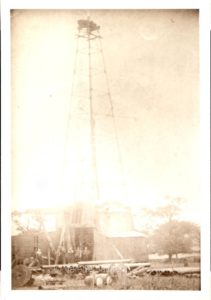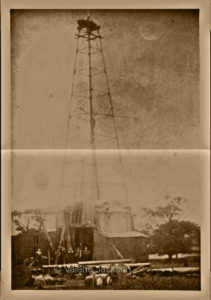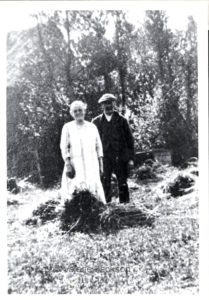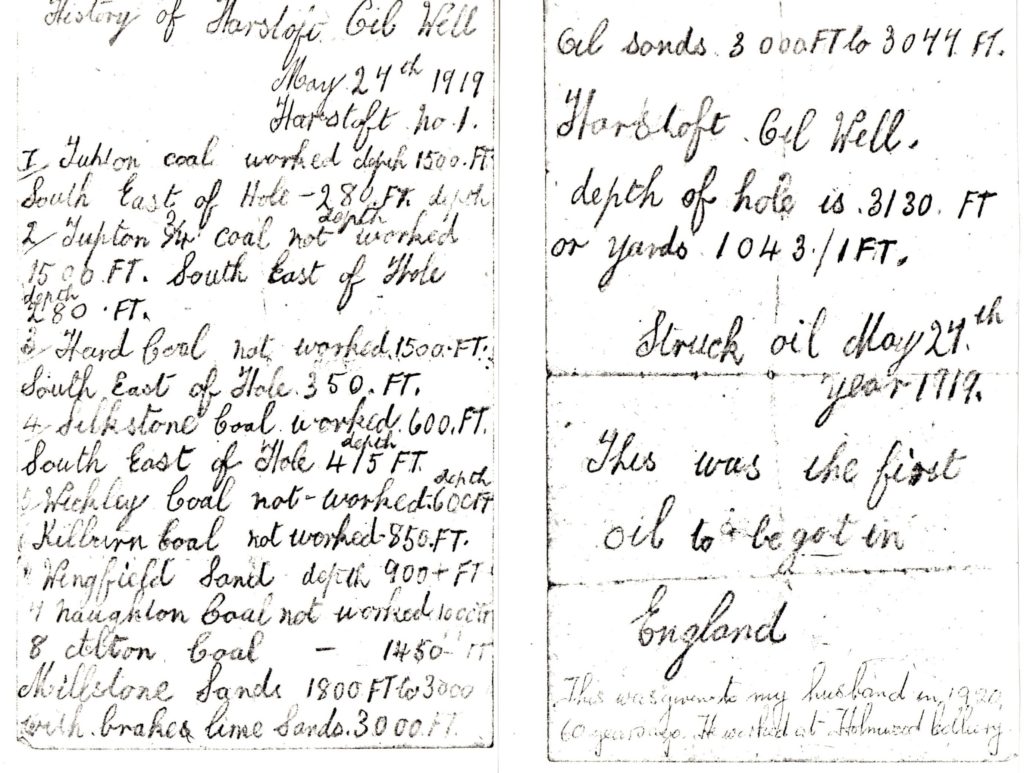|
In 1915 in effort to reduce the country’s dependence on oil imports the Government decided to investigate potential oil resources in the UK. The Government Oil Production Committee met early on in the war to discuss the problems of oil, submarines were threatening supplies and the Royal Navy had converted some of its ships’ steam raising from coal fired to oil fired.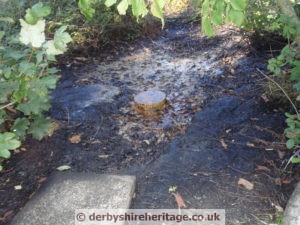
As a result of the survey undertaken by Lord Cowdray’s firm of S Pearson and Sons three regions where identified as having the greatest potential for oil to be found. These regions were the Lothians of Scotland, the North Derbyshire coalfield area and the Potteries in North Staffordshire.
Oil seepages had already been found in local collieries and American drillers were employed to drive test bores as they had the technical expertise and necessary drilling equipment compared to British drilling equipment and procedures which were outdated. However because the United States of America (which was still neutral) had declared oil equipment strategic material it could not be bought by foreigners. This problem was overcome by hiring American drilling teams to come to the UK, bringing their own equipment.
The drillers lived on site in two wooden houses which were heated in 1925 with gas fired heating – the gas being a by product associated with the oil. 2,500 tons (20,000 US barrels) were produced up to December 1927 at an average rate of 6 barrels per day.
The oil produced was described as ‘being dark brown in colour with a green fluorescence, of good quality resembling Pennsylvanian crude (an oil with a high percentage of oils suitable for steam cylinder lubrication) and light gravity with paraffin base‘.
Originally the Oilwell at Hardstoft drilling was carried out under the Defence of the Realm Act which was repealed following the end of the First World War. Also the Petroleum Production Act of 1918 was lost on amendment of its second reading as Labour MPs objected to payment of royalties to landowners. Thus there was dispute over the oil ownership and ultimately the Duke of Devonshire served an injunction on the Government.
In 1921 The Government decided to close all the 11 original wells except Hardstoft and D’Arcy (in Lothian, Scotland) whilst Parliament resolved the oil ownership question.
The Duke of Devonshire who owned the oil and mineral rights and the land on which the well was sunk took over the Hardstoft Oil Well in March 1923 in so doing he paid the Government for the equipment and compensation to the Babbington Colliery Company as a 2½ acre pillar of coal had to remain around the bore. The Government was allowed to keep the money for oil so far sold and paid for 500 tons of stock.
Initially oil was stored on site in a 12,000 barrel tank before being transported to Pilsley Station to be dispatched to a refinery. Later a 4,500 ft gravity fed pipeline was installed direct from the well to Pilsley Station.
Oil ownership was finally resolved in 1934 when the Petroleum Production Act gave oil ownership in the Crown with the exception of the three existing licences, one of whom was the Duke of Devonshire at Hardstoft. Two of these licences lapsed in the 1940s and the Duke currently remains as the only person in the UK today to have the rights to the oil under his land.
Silting up created problems and production dropped whenever this occurred. In 1923 a month was spent removing the silt but became a problem again in 1924. This lead to the decision to convert the well from a natural flow system to a pumped system. Although this improved production for the period from 1927 to 1938 there was insufficient oil to make the well commercially viable and Chatsworth Estates used the unrefined oil to power the sawmill at nearby Hardwick Hall.
Two additional wells were sunk in the 1920’s in the hope of finding further oil reserves.
Hardstoft No 2 was drilled in May 1924, 600ft to the west of Hardstoft No 1 but was plugged with cement and abandoned in March 1925 after failing to strike oil. However this well struck gas at 1,620ft and produced 20,000 cubic feet per day at a pressure of 370 lbs per square inch. It was this gas that was subsequently used to fuel the boilers and heat the workers’ houses on the site.
Well No 3 was drilled by the American Oil Company in Aug 1925, about 600ft northeast of No 1 well but hit hard rock strata known locally as Porter’s Rock causing equipment breakages. The drilling passed through old coal mine workings, encountered unexpected water ingress which flattened the well casing and found an insignificant quantity of thick oil at 1,500 ft. After reaching 3,825ft and failing to strike oil the bore was abandoned in June 1926.
By 1938 the No 1 Hardstoft well was nearing exhaustion so was deepened to increase production saving the well for a few more years until it closed in July 1945 and was finally capped in 1952.
As a derelict tree covered site the Oilwell at Hardstoft was sold in 1957.
Rubble from the demolished Army camp at Hardwick was tipped on it raising the ground level by 15-20ft and trees cut down despite being part of a tree preservation order.
In September 1961 the site was levelled and graded and nature slowly reclaimed the area until in 1977 Mr P Schofleld acquired the site and developed a Nursery and Garden Centre.
With the permission of the Nursery owner it is possible to see Hardstoft No.1 well head and the concrete base for the ‘nodding donkey’. It still seeps a small amount of crude oil and the hydrocarbon smell is very obvious.
Copies of the booklet ‘Britain’s First Mainland Oilwell at Tibshelf/Hardstoft’ by Ivan Brentnall, on which this page is based, can be purchased at the Oilwells Garden Centre. It gives great detail about the oil wells and production.
|


